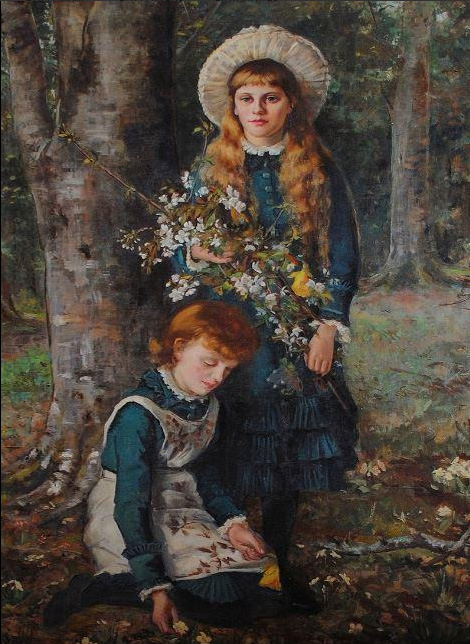Tonight, the Irish journalist Mary Kenny has a play on at the Irish Cultural Centre. Entitled Dearest Old Darling, it’s based on letters sent between the Dublin feminist, socialist, communist, Sinn Fein MP (elect, but never sitting) Constance Markievicz – née Gore-Booth – and her sister Eva.
My great-great-great-aunt, Sarah Purser, portraitist, landscape artist, and leading light (no pun) in the Irish stained glass industry revival, once made a well-known painting of these sisters.
According to John O’Grady’s monograph, The Life and Work of Sarah Purser, this double portrait was commissioned by ‘enlightened resident landlord [and] amateur Arctic explorer’ Sir Henry and his wife Lady Georgina Gore-Booth, of Lissadell, Co. Sligo, in about 1882, when the sisters were roughly 14 (Constance) and 12 (Eva). It is approximately life size, and in its style and setting (a beech grove, apparently) it is thought ‘boldly unconventional’ for the Ireland of the time – and it is credited, writes Elizabeth Coxhead in Daughters of Erin, with being ‘one of the two pictures which put [Purser] on the road to success’.
The original ‘Constance and Eva Gore-Booth’ is displayed at Lissadell House to this day, where it’s available to members of the public in the summer. I must admit I’m not in love with it; if anything, I’d say it’s most remarkable for the fact that it betrays – and fair enough – nothing at all of the hard-line, gun-toting political activist that Constance Gore-Booth/Markievicz was to become. That said, a few years later Constance went to study painting with a friend of Purser’s, and progressed, from there, to the French Académie Julian, where – fatefully? – she met Count Casimir…
No inconsiderable lady in her own right, Sarah Purser (1848-1943) was born into a financially-unstable offshoot of the Guinness-brewing Purser clan. Taking her future in her own hands, she set off to train in Paris (on ‘a pound a week’), and was exhibiting at the Royal Hibernian Academy of Arts by the age of 23. Three years later the Royal Dublin Society awarded her a certificate for still lifes, and before long she was elected an Honorary Academician of the RHA, whose first female full member she eventually became in 1924.
She founded the An Túr Gloine (Tower of Glass) stained glass cooperative in 1903, which she then ran for almost 40 years. She helped establish Dublin’s Municipal Gallery of Modern Art and develop the National Gallery of Ireland, where various of her portraits (and much stained glass produced under her sponsorship) now, quite properly, reside.
Often referred to in the same breath as Markievicz, Maud Gonne, Lady Gregory, and other notable women of the era (and indeed Eire), Purser moved in very much the same cultural circles – minus the Catholicism part; she being of Huguenot descent – and went on to paint all of the aforementioned (including Constance several times again), as well as luminaries like WB Yeats, Roger Casement, Douglas Hyde and Brendan Behan’s mother, Kathleen Kearney (‘The blue hat’. (It was Behan’s grandmother, NB, who famously took her bath ‘every year, whether she was dirty or not’)). Her continued friendship with the Gore-Booths was particularly helpful, work-wise. She once remarked that she “went through the British aristocracy like the measles.”
Now and then, the increasingly ‘indomitable’ Purser was herself sketched and painted, among others by John Butler Yeats, WB and Jack’s father. JB’s somewhat beaky portrait especially seems to reflect not some head-in-the-clouds romantic artiste but a professional arts-and-crafts intellectual whose income, for the most part, came through her quite astute investments – in particular, in Guinness. Her large home, Mespil House, on Dublin’s Grand Canal, became, in John O’Grady’s words, ‘a salon frequented by writers, politicians, visionaries and revolutionaries.’
One contemporary describes this scene as ‘full of bubbling gaiety’, and Coxhead claims that Purser’s later portraits were ‘not done for money, but for love of good talk and good company.’ This may be true; but the family remembers her as something of a fierce old stick (‘not notoriously a cuddly creature’ was, I think, my father’s summary), who once threw out a burglar just by talking at him, and who, aged 89, demanded to be taken up by Oliver Gogarty (Buck Mulligan in Ulysses) in his private plane, to inspect the house roof, then wrote complaining to her landlord – to be informed, rather politely, that her lease had actually expired a decade previous.
Artistically, though, she’d become most definitely someone to be reckoned with. She was wont to give her sitters ‘a few scoldings and home-truths’ along with their likenesses; she objected strongly to Catholic bishops having their official portraits done in Rome, not locally; she once gave Yeats an earful for suggesting one of her artists’ windows was derived from an old German print; and in the last week of her life she wrote in fury to the President of Ireland (a former sitter) to excoriate him for the ‘bad art’ on a recent postage stamp.
With her caustic wit and enthusiasm for ‘discussion’ to the fore, and her personal network of poets, painters, politicians, and the occasional heavyweight boxing champion all around her, on the second Tuesday of every month, regular, she hosted, presided over, held forth, and generally tried to bend all aspects of the Irish national culture to her will. For thirty years her soirées were widely considered to be unmissable – if only in the sense that half the guests came primarily out of fear of what might well be said about them in their absence. It was not for nothing these ‘at homes’ became known to Dublin wags as Sarah Purser’s ‘dies irae’.
Still fuming at the business of the ugly stamp, she died on August 7th, 1943. Her funeral, her friends were not too grieved to note, was on the second Tuesday of the month.

Post a Comment